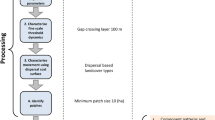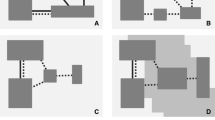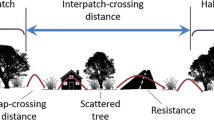Abstract
Context
Methods quantifying habitat patch importance for maintaining habitat network connectivity have been emphasized in helping to prioritize conservation actions. Functional connectivity is accepted as depending on landscape resistance, and several measures of functional inter-patch distance have been designed. However, how the inter-patch distance, i.e., based on least-cost path or multiple paths, influences the identification of key habitat patches has not been explored.
Objectives
We compared the prioritization of habitat patches according to least-cost distance (LCD) and resistance distance (RD), using common binary and probabilistic connectivity metrics.
Methods
Our comparison was based on a generic functional group of forest mammals with different dispersal distances, and was applied to two landscapes differing in their spatial extent and fragmentation level.
Results
We found that habitat patch prioritization did not depend on distance type when considering the role of patch as contributing to dispersal fluxes. However, the role of patch as a connector facilitating dispersal might be overestimated by LCD-based indices compared with RD for short- and medium-distance dispersal. In particular, when prioritization was based on dispersal probability, the consideration of alternatives routes identified the connectors that probably provided functional connectivity for species in the long term. However, the use of LCD might help identify landscape areas that need critical restoration to improve individual dispersal.
Conclusions
Our results provide new insights about the way that inter-patch distance is viewed changes the evaluation of functional connectivity. Accordingly, prioritization methods should be carefully selected according to assumptions about population functioning and conservation aims.







Similar content being viewed by others
References
Adriaensen F, Chardon JP, De Blust G, Swinnen E, Villalba S, Gulinck H, Matthysen E (2003) The application of ‘least-cost’ modelling as a functional landscape model. Landsc Urban Plan 64(4):233–247
Amos JN, Harrisson KA, Radford JQ, White M, Newell G, Mac Nally R, Sunnucks P, Pavlova A (2014) Species- and sex-specific connectivity effects of habitat fragmentation in a suite of woodland birds. Ecology 95(6):1556–1568
Ayram CAC, Mendoza ME, Salicrup DRP, Granados EL (2014) Identifying potential conservation areas in the Cuitzeo Lake Basin, Mexico by multitemporal analysis of landscape connectivity. J Nat Conserv 22(5):424–435
Baranyi G, Saura S, Podani J, Jordan F (2011) Contribution of habitat patches to network connectivity: redundancy and uniqueness of topological indices. Ecol Indic 11(5):1301–1310
Beier P, Spencer W, Baldwin RF, McRae BH (2011) Toward best practices for developing regional connectivity maps. Conserv Biol 25(5):879–892
Belisle M (2005) Measuring landscape connectivity: the challenge of behavioral landscape ecology. Ecology 86(8):1988–1995
Bodin O, Saura S (2010) Ranking individual habitat patches as connectivity providers: integrating network analysis and patch removal experiments. Ecol Model 221(19):2393–2405
Clauzel C, Girardet X, Foltete JC (2013) Impact assessment of a high-speed railway line on species distribution: application to the European tree frog (Hyla arborea) in Franche-Comte. J Environ Manag 127:125–134
Didham RK, Kapos V, Ewers RM (2012) Rethinking the conceptual foundations of habitat fragmentation research. Oikos 121(2):161–170
Ernst BW (2014) Quantifying landscape connectivity through the use of connectivity response curves. Landscape Ecol 29(6):963–978
Estrada E, Bodin O (2008) Using network centrality measures to manage landscape connectivity. Ecol Appl 18(7):1810–1825
Fletcher RJ, Acevedo MA, Robertson EP (2014) The matrix alters the role of path redundancy on patch colonization rates. Ecology 95(6):1444–1450
Foltete JC, Girardet X, Clauzel C (2014) A methodological framework for the use of landscape graphs in land-use planning. Landsc Urban Plan 124:140–150
Galpern P, Manseau M, Fall A (2011) Patch-based graphs of landscape connectivity: a guide to construction, analysis and application for conservation. Biol Conserv 144(1):44–55
Garcia-Feced C, Saura S, Elena-Rossello R (2011) Improving landscape connectivity in forest districts: a two-stage process for prioritizing agricultural patches for reforestation. For Ecol Manag 261(1):154–161
Gimona A, Poggio L, Brown I, Castellazzi M (2012) Woodland networks in a changing climate: threats from land use change. Biol Conserv 149(1):93–102
Gurrutxaga M, Rubio L, Saura S (2011) Key connectors in protected forest area networks and the impact of highways: a transnational case study from the Cantabrian Range to the Western Alps (SW Europe). Landsc Urban Plan 101(4):310–320
Gurrutxaga M, Saura S (2014) Prioritizing highway defragmentation locations for restoring landscape connectivity. Environ Conserv 41(2):157–164
Koen EL, Bowman J, Walpole AA (2012) The effect of cost surface parameterization on landscape resistance estimates. Mol Ecol Resour 12(4):686–696
Koen EL, Garroway CJ, Wilson PJ, Bowman J (2010) The effect of map boundary on estimates of landscape resistance to animal movement. PLoS One 5(7):e11785
LaPoint S, Gallery P, Wikelski M, Kays R (2013) Animal behavior, cost-based corridor models, and real corridors. Landscape Ecol 28(8):1615–1630
Lawler JJ, Ruesch AS, Olden JD, McRae BH (2013) Projected climate-driven faunal movement routes. Ecol Lett 16(8):1014–1022
Marrotte RR, Gonzalez A, Millien V (2014) Landscape resistance and habitat combine to provide an optimal model of genetic structure and connectivity at the range margin of a small mammal. Mol Ecol 23(16):3983–3998
Mateo-Sanchez MC, Balkenhol N, Cushman S, Perez T, Dominguez A, Saura S (2015) Estimating effective landscape distances and movement corridors: comparison of habitat and genetic data. Ecosphere 6(4):art59
McRae BH (2012) Pinchpoint mapper connectivity analysis software. The Nature Conservancy, Seattle
McRae BH, Beier P (2007) Circuit theory predicts gene flow in plant and animal populations. Proc Natl Acad Sci USA 104(50):19885–19890
McRae BH, Dickson BG, Keitt TH, Shah VB (2008) Using circuit theory to model connectivity in ecology, evolution, and conservation. Ecology 89(10):2712–2724
McRae BH, Kavanagh DM (2011) Linkage mapper connectivity analysis software. The Nature Conservancy, Seattle
Neel MC (2008) Patch connectivity and genetic diversity conservation in the federally endangered and narrowly endemnoc plant species Astragalus albens (Fabaceae). Biol Conserv 141(4):938–955
Pascual-Hortal L, Saura S (2006) Comparison and development of new graph-based landscape connectivity indices: towards the prioritization of habitat patches and corridors for conservation. Landscape Ecol 21(7):959–967
Pinto N, Keitt TH (2009) Beyond the least-cost path: evaluating corridor redundancy using a graph-theoretic approach. Landscape Ecol 24(2):253–266
Poor EE, Loucks C, Jakes A, Urban DL (2012) Comparing habitat suitability and connectivity modeling methods for conserving pronghorn migrations. PLoS One 7(11):e49390
Rayfield B, Fortin MJ, Fall A (2011) Connectivity for conservation: a framework to classify network measures. Ecology 92(4):847–858
Roever CL, van Aarde RJ, Leggett K (2013) Functional connectivity within conservation networks: delineating corridors for African elephants. Biol Conserv 157:128–135
Rowcliffe JM, Carbone C, Kays R, Kranstauber B, Jansen PA (2012) Bias in estimating animal travel distance: the effect of sampling frequency. Methods Ecol Evol 3(4):653–662
Saura S, Bodin O, Fortin MJ (2014) Stepping stones are crucial for species’ long-distance dispersal and range expansion through habitat networks. J Appl Ecol 51(1):171–182
Saura S, Pascual-Hortal L (2007) A new habitat availability index to integrate connectivity in landscape conservation planning: comparison with existing indices and application to a case study. Landsc Urban Plan 83(2–3):91–103
Saura S, Rubio L (2010) A common currency for the different ways in which patches and links can contribute to habitat availability and connectivity in the landscape. Ecography 33(3):523–537
Saura S, Torne J (2009) Conefor Sensinode 2.2: a software package for quantifying the importance of habitat patches for landscape connectivity. Environ Model Softw 24(1):135–139
Shah VB, McRae BH (2008) Circuitscape: a tool for landscape ecology. In: Varoquaux G., Vaught, T, Millman J (eds) Proceedings of the 7th python in science conference (SciPy 2008), 2008, pp 62–66
Stevens VM, Verkenne C, Vandewoestijne S, Wesselingh RA, Baguette M (2006) Gene flow and functional connectivity in the natterjack toad. Mol Ecol 15(9):2333–2344
Urban D, Keitt T (2001) Landscape connectivity: a graph-theoretic perspective. Ecology 82(5):1205–1218
Urban DL, Minor ES, Treml EA, Schick RS (2009) Graph models of habitat mosaics. Ecol Lett 12(3):260–273
Verbeylen G, De Bruyn L, Adriaensen F, Matthysen E (2003) Does matrix resistance influence Red squirrel (Sciurus vulgaris L. 1758) distribution in an urban landscape? Landscape Ecol 18(8):791–805
Wang JL (2004) Application of the one-migrant-per-generation rule to conservation and management. Conserv Biol 18(2):332–343
Watts K, Eycott AE, Handley P, Ray D, Humphrey JW, Quine CP (2010) Targeting and evaluating biodiversity conservation action within fragmented landscapes: an approach based on generic focal species and least-cost networks. Landscape Ecol 25(9):1305–1318
Wauters LA, Verbeylen G, Preatoni D, Martinoli A, Matthysen E (2010) Dispersal and habitat cuing of Eurasian red squirrels in fragmented habitats. Popul Ecol 52(4):527–536
Zeller KA, McGarigal K, Whiteley AR (2012) Estimating landscape resistance to movement: a review. Landscape Ecol 27(6):777–797
Zetterberg A, Mortberg UM, Balfors B (2010) Making graph theory operational for landscape ecological assessments, planning, and design. Landsc Urban Plan 95(4):181–191
Acknowledgments
C.A. was supported by Region PACA (APRF 2011 projet Alterbio PACA) and Irstea.
Author information
Authors and Affiliations
Corresponding author
Electronic supplementary material
Below is the link to the electronic supplementary material.
Rights and permissions
About this article
Cite this article
Avon, C., Bergès, L. Prioritization of habitat patches for landscape connectivity conservation differs between least-cost and resistance distances. Landscape Ecol 31, 1551–1565 (2016). https://doi.org/10.1007/s10980-015-0336-8
Received:
Accepted:
Published:
Issue Date:
DOI: https://doi.org/10.1007/s10980-015-0336-8




